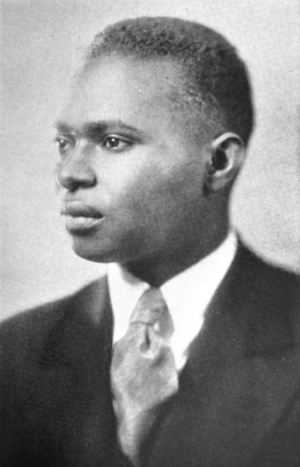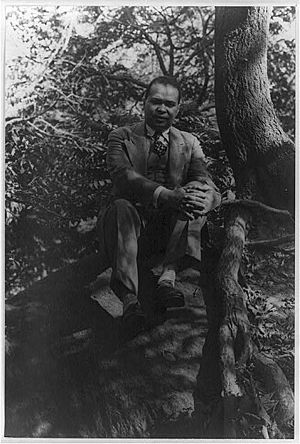Countee Cullen facts for kids
Quick facts for kids
Countee Cullen
|
|
|---|---|

Countee Cullen, c. 1927
|
|
| Born | Countee LeRoy Porter May 30, 1903 |
| Died | January 9, 1946 (aged 42) |
| Occupation | Writer |
| Nationality | American |
| Alma mater | New York University; Harvard University |
| Period | 1923–46 |
| Genre | Poetry |
| Literary movement | Harlem Renaissance |
| Spouse | Yolande Du Bois, m. 1928–d. 1930; Ida Mae Roberson, m. 1940 |
Countee Cullen (born Countee LeRoy Porter; May 30, 1903 – January 9, 1946) was an American writer. He was a poet, novelist, and wrote for children and plays. Cullen was especially famous during the Harlem Renaissance. This was a time when African-American art and culture thrived.
Contents
Early Life and Education
Childhood Years
Countee LeRoy Porter was born on May 30, 1903. Historians are not sure where he was born. Possible places include Baltimore, Maryland, New York City, or Louisville, Kentucky. Cullen himself often said he was born in New York City.
When he was nine, he moved to Harlem with Amanda Porter. She was believed to be his grandmother. After she passed away in 1917, Countee was adopted. Reverend Frederick Asbury Cullen, a pastor, and his wife, Carolyn Belle Mitchell, adopted him. Reverend Cullen was a very important person in Countee's life. He was also a leader in the NAACP.
High School Success
Cullen went to DeWitt Clinton High School in New York City. He was an excellent student there. He started writing poetry and even won a citywide poetry contest.
At DeWitt, he joined the honor society. He was also the editor of the school newspaper. He became the vice-president of his graduating class. In 1922, he graduated with high honors. He excelled in Latin, Greek, Math, and French.
College and Early Writing
After high school, Cullen attended New York University (NYU). In 1923, he won an award for his poems. His book of poems was called "The Ballad of the Brown Girl." Soon, his poems appeared in famous magazines. These included Harper's, Crisis, and Poetry. This made him well-known across the country.
He won more poetry awards in the following years. In 1925, he graduated from NYU. He was chosen for the Phi Beta Kappa honor society.
That same year, Cullen went to Harvard University for his master's degree. He also published Color. This was his first collection of poems. It became a very important work of the Harlem Renaissance. His poems celebrated black beauty. They also spoke out against racism. This book included "Heritage" and "Incident," which are two of his most famous poems.
In 1926, Cullen earned his master's degree. He also helped edit a special issue of Palms magazine. It featured "Negro Poets." This led to Harper's asking him to edit a collection of Black poetry in 1927.
Personal Life
Cullen married Yolande Du Bois on April 9, 1928. She was the daughter of W. E. B. Du Bois, a famous leader. Their wedding was a huge event for the African-American community. About 3,000 people came to the church. Cullen's father, Frederick A. Cullen, performed the ceremony.
Cullen and Yolande divorced in 1930. In 1940, he married Ida Mae Roberson. They lived together until his death. Cullen was a private person.
The Harlem Renaissance

The Harlem Renaissance was a huge burst of art and culture. It happened in Harlem, New York City. Many talented African-American writers and artists moved there. During the 1920s, a new group of Black writers became famous.
Other important figures included Langston Hughes, Zora Neale Hurston, and James Weldon Johnson. These writers received help from grants and scholarships. They were also supported by white writers like Carl Van Vechten.
The Harlem Renaissance was also shaped by a movement called Négritude. This movement was about discovering black culture and pride. Cullen believed Negritude helped awaken black identity. His poems "Heritage" and "Dark Tower" show ideas from this movement. They explore African roots and connect them to African-American life.
Cullen's work was connected to other Harlem Renaissance artists. These included Duke Ellington and Langston Hughes. Ellington admired Cullen for facing hard times. Hughes, however, sometimes felt Cullen and others tried to be "too American." But Hughes still respected Cullen's writing.
Professional Career
The Harlem Renaissance was a time when African-American writers and artists created many important works. Cullen was a central figure in this movement. He believed poetry should not be limited by race.
Cullen worked as an assistant editor for Opportunity magazine. His column, "The Dark Tower," made him even more famous. His poetry collections The Ballad of the Brown Girl (1927) and Copper Sun (1927) explored similar ideas as Color.
In 1928, Cullen received a special award called a Guggenheim Fellowship. This allowed him to study and write in other countries. Between 1928 and 1934, he traveled between France and the United States. By 1929, he had published four books of poetry.
Cullen also helped other Black writers. But by 1930, his fame as a poet began to fade. In 1932, he published his only novel, One Way to Heaven. It was a funny story about different groups of Black people in New York City.
From 1934 until he died, Cullen taught at Frederick Douglass Junior High School in New York City. He taught English, French, and creative writing. During this time, he also wrote two books for young readers. These were The Lost Zoo (1940) and My Lives and How I Lost Them. The second book was about his cat.
Later in his life, Cullen mostly wrote for the theater. He worked with Arna Bontemps on a musical called St. Louis Woman (1946). He also translated a Greek play called Medea by Euripides. It was published in 1935.
Cullen passed away on January 9, 1946, at age 42. He is buried in Woodlawn Cemetery in The Bronx, New York City.
Honors
The Countee Cullen Library in Harlem was named after him. In 2013, he was added to the New York Writers Hall of Fame. In 1949, a radio show called Destination Freedom told parts of his life story.
Literary Style and Influences
Cullen believed that poetry could go beyond race. He thought it could bring people together. Even though race was often in his poems, he wanted to be known as a poet, not just a "Black poet."
He learned a lot from Greek and Roman classics. He also studied English Literature at NYU and Harvard. His poems sometimes used Greek stories to explore ideas about race.
Cullen was also influenced by Romantic poets like John Keats. He wrote about love, romance, and religion. In a book he edited called Caroling Dusk, he shared his ideas. He believed African-American poets should use traditional English poetry styles. He thought this would show that Black Americans could also create great works in these styles. He hoped this would help build bridges between different communities.
Major Works
Color
Color was Countee Cullen's first published book. It talks a lot about race. Cullen explores how people feel about their heritage. He also writes about the challenges of being Black in America. Through his poems, readers can understand his thoughts about the African-American experience.
"Heritage" is one of his most famous poems from this book. It was written when many African-American artists were thinking about Africa. Cullen, Langston Hughes, and others wanted to connect Africa to their lives. In "Heritage," Cullen deals with the loss of his African culture due to slavery. He knew Africa only through stories. He wondered about the cost of his ancestors' forced changes.
The Black Christ
The Black Christ was a collection of poems published in 1929. These poems look at faith and fairness for African Americans. In some poems, Cullen compares the suffering of Jesus to the suffering of Black people. This book shows Cullen's pride in his race. It also shows his questions about religion. The Black Christ also looks closely at racial violence in America in the 1920s.
Copper Sun
Copper Sun is a poetry collection from 1927. It explores the idea of love, especially love between white and Black people. Sometimes, love in these poems leads to sadness. But generally, love is shown to connect people and nature. Many poems also link love to Christian ideas.
In his poem "One Day We Played a Game," love is shown as very important. The poem suggests that love is needed to keep going in life. It is as basic as the foundation of a home. Similarly, in "Love's Way," Cullen shows love as something that shares and unites the world. The poem says that "love is not demanding." It suggests that "Love rehabilitates unto the end," meaning love can fix and heal things.
Poetry Collections
- Color, Harper & Brothers, 1925
- Copper Sun, Harper & Brothers, 1927
- Harlem Wine (1926)
- The Ballad of the Brown Girl, Harper & Brothers, 1927
- The Black Christ and Other Poems, Harper & Brothers, 1929
- Tableau (1925)
- One Way to Heaven, Harper & Brothers, 1932
- Any Human to Another (1934)
- The Medea and Some Other Poems (1935)
- On These I Stand: An Anthology of the Best Poems of Countee Cullen, Harper & Brothers Publishers, 1947
- My Soul's High Song: The Collected Writings of Countee Cullen, Doubleday, 1991
- Countee Cullen: Collected Poems, Library of America, 2013
Prose (Stories)
- One Way to Heaven (1931)
- The Lost Zoo, Harper & Brothers, 1940
- My Lives and How I Lost Them, Harper & Brothers Publishers, 1942
Drama (Plays)
- St. Louis Woman (1946)
As Editor
- Caroling Dusk: An Anthology of Verse by Black Poets of the Twenties: Anthology of Black Verse. New York: Harper & Brothers, 1927.
Images for kids
See also
 In Spanish: Countee Cullen para niños
In Spanish: Countee Cullen para niños
- African-American literature
- Harlem Renaissance





